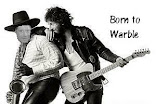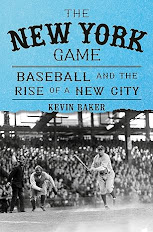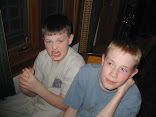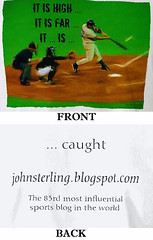I've got a bit of a bone to pick with this guy, David Schoenfield, who writes for ESPN's Sweet Spot. In a post today entitled, "Pineda suspended, but ramifications?," Shoenfield writes:
The bigger issue here remains: Is this something teams, managers and MLB will be willing to crack down on moving forward with other pitchers? Or even want to? As offense continues to decline and strikeouts continue to rise to ridiculous levels, has the game swung too far in favor of the pitchers? Is it just a coincidence that pitchers are dominating at the same time the use of pine tar or spray-on sunscreen is apparently so widespread that the reaction from within the game was basically, "Pineda just should have done a better job of hiding it"?Last year, with 30 major league teams, the cumulative BA was .253, with 4,661 HRs and 20,255 runs scored. For those of you keeping score at home:
BA: .253
HR per team, average: 155.36
Runs per team: 675.16
Runs per team per game: 4.167
Strikeouts: 7.6
In 1998, when the bulging physiques of McGwire and Sosa hit a bazillion homers apiece -- maybe the height of steroidal madness if you minus Bonds -- there were 5,064 home runs and 23,297 runs:
BA: .266
 HR per team, average: 168.8
HR per team, average: 168.8Runs per team: 776.56
Runs per team per game: 4.167
Strikeouts: 6.6
In the good old steroid/PED heydays of 1999, batters went that one better:
BA: .271
HR per team, average: 184.26
Runs per team: 823.03
Runs per team per game: 5.08
Strikeouts: 6.5
Let's go back to 1961. That year, baseball expanded the number of major league teams to 18 and the number of games per season to 162. The "watered down" pitching and extra games were cited by those who poo-pooed Maris' record 61 homers and even Mantle's then-impressive 54. So you'd think the offense would be pretty hot overall that year. But...
BA: .258
HR per team, average: 151.66
Runs per team: 719
Runs per team per game: 4.43
Strikeouts: 5.12
Basically, except for the strikeouts, this is pretty much what we saw last year, with 30 teams facing even more "watered down" pitching.
Jump to 1985. The mound had been lowered almost two decades before, the wisdom of the elders determining that Gibson's amazing ERA of 1.12 in 1968 was a sign that offense needed goosing. (The DH would come not long after, to goose the AL even more.) PEDs were limited to coffee and maybe some greenies, perhaps a few piles of coke here and there.
BA: .253
HR average: 138.53
Runs: 700
Runs per team per game: 4.3
Strikeouts: 5.4
Fewer home runs back back in '85 for sure, but I don't remember hearing the alarm bells going off about the terrible decline in offense in those days. And in terms of runs, runs per team per game, and BA, pretty dang close to last year.
So, the point: when Schoenfield bemoans today's declining offense and "ridiculous levels" of strikeouts, what's he comparing today's offense to, exactly? The strikeouts are high, but I'd say that's because the fences have been pulled in to "ridiculous levels" in a lot of parks compared to 30 or 50 years ago and that -- along with the emphasis on the HR that really hit its stride in the post-strike steroidal desperation of Bud Selig and a lot of frightened owners -- players have learned to swing for the fences a lot more than they used to. If pitching was really dominant today, the other offensive numbers would be more in line with the SO9 number, and reflect that domination.
I think, like a lot of today's sportswriters and fans, Schoenfield basically grew up during a statistically freakish era when men were men and expected to stick a needle in each other's butts. Where we are today is somewhere in the historical ballpark for offensive numbers.
Let's hope he's an anomaly and not the beginning of a new wave of sportswriter stupidity.












































8 comments:
You had me at 20,000 runs.
I can really be such a geek.
Steroids are a part of it but to say its the whole story is to be willfully ignorant of advances in the game. Offense is at mid 60s levels in 2014 right now (literally, the .249 BA is tied with 1966). While you posted a bunch of numbers, the fact is 2013 BA of .253 was lower than every single year since 1971, and 2014 is shaping up to be even lower. That its even this close to the 60s even WITH offensive advantages like a lower mound and a DH in half the games implies that there has been an additional shift downward in offense beyond steroids.
Significant research is being conducted in every front office to increase run prevention and findings are being implemented. see: record shattering usage of defensive shifts, super specialized bullpen pitchers throwing 100MPH for 1 inning, wider acknowledgement of the value of players with strong defensive skills but lesser hitting ability, etc.
So far there's no real way to leverage all of the data front offices have to increase scoring. You can make your defensive strategy better and better utilize your bullpen, but you can't really do much (yet) to make your hitters better.
I don't think its a bad thing (or a good thing either), but it is the current trend in the game.
Joey Beans makes some excellent points. Short of bringing in all fences to Little League Dimensions, I think stricter enforcement of the foreign-substance prohibition would go a long way toward restoring pitcher-batter balance. Doc Gooden's tweet of yesterday confirmed my contention that the MLB party line (parroted by the brain-dead daily sportswriters)--that loading up enhances control and prevents accidental beanings--is hogwash, and that the real benefit is for the pitcher, enhancing the movement on breaking pitches and sinkers. Clearly Pineda had better movement on his sinker with the gunk than without it.
MLB is so hapless about this and a host of matters--the next frontier will be the calling of balls and strikes, which remains scandalously inconsistent and incompetent from ump to ump. The technology exists right now to rectify this chaos with an electronic sound-cue system of ball-strike calls. It will probably take another ten or twenty years to overcome MLB's bureaucratic stasis, but it will happen.
Is MLB willing to do a TSA-style pat-down and grope on all pitchers every time they take the mound? Minus this, I don't see how the foreign substances can possibly be removed from the equation.
Wonderful post John M!
GREAT post John M!
John,
A great post. There is, however, one flaw.
You start with the premise that any ESPN writer should know how to do basic research.
The ability to intelligently examine statistics -- or do any basic research, for that matter -- is a skill that is difficult to find in ESPN writers not named Jayson Stark.
Example A: Last year's hatchet job on Alex Rodriguez by Johnette Howard, which basically stated that the "spike in performance" by A-Rod in 2009 pretty much proved his was guilty of steroid abuse. This statement was so ridiculous it was mind-boggling.
Spike in performance? Here are A-Rod's 2009 stats:
HRs: 30, his lowest total in 12 years; RBIs: 100, his lowest total in 12 years; batting average: .286, tied for his lowest in nine years; slugging pct: .532, down for the second straight year and a full .113 below his 2007 mark; and OPS+: 138, down for the second straight year and 38 points below his 2007 total.
A-Rod got hot in September that year, true, but if you're going to say that alone is proof that he was using 'roids, well, sorry. Even with the hot September, A-Rod had more HRs and a higher OPS+, OBP and slugging percentage in the first half than in the second half.
Sorry to get all geeky, but basically, the "spike in performance" didn't happen. Even a tiny bit of reasearch would have shown otherwise. But that's too much for ESPN.
OK, sorry. I'll go back to non-geek mode now.
Post a Comment